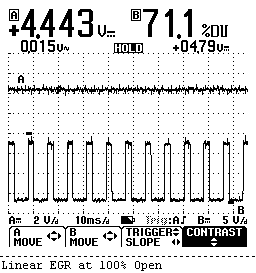
Some Insight On General Motors Linear EGR Valve

What a simple EGR system, solenoid operated pintle, and an internal position sensor to tell PCM its amount of opening. PCM sends a PWM (Pulse Width Modulated) ground signal to operate EGR. PCM will test the system by opening pintle slightly during deceleration and monitoring MAP signal for change. Codes will set for, no flow, incorrect position, and position circuit. Image above shows valve open at 25% commanded by PCM with scantool. Trace (A) is position signal to PCM, trace (B) is ground signal to solenoid coil showing negative duty cycle percentage. As more flow is commanded, duty cycle increases to allow more pintle lift.

Here is the valve open at 75% as indicated by more duty cycle and higher position volts.

And at 100%. Notice how much wider the pulse is during its stay at ground. At 0% the ground side of the coil will show 0% duty cycle, and full battery voltage. If you can't do duty cycle with your scope, just look at battery voltage and watch voltage drop as ground signal increases in pulse width, position signal at 0% should be around .6 to .8 volts.
This is a very expensive valve, so you better know whats wrong with the system before you decide to replace it, it may come back to haunt you.
I have found the valve itself to be fairly trouble free, the big problem with these is chunks of carbon get stuck between the pintle and seat and hang the valve open causing a rough idle or stalling, this will set a code.
When you find a code set for these, how do you make the decision to replace the valve? If you have the scantool that will allow you to operate the valve through the PCM, the normal procedure is to do so at various percentages and watch the commanded vs. actual open and closed percentage, if it closes to 0% and opens to 100%, test indicates the valve is ok, and can do what is expected of it. While running the test, you will know if the valve is actually flowing gases by watching MAP signal change or even just hearing rpm drop.
So, now you have a EGR error code and the system and valve test ok, now what? Obviously its an intermittent, and you need to monitor signals to and from the valve looking for any intermittent loss of signals such as coil positive and negative. If the valve quits operating, the PCM will see it and set the code.
If all checks out and you find no problem, it had to be a chunk of carbon hanging the valve. If it happens very often, you are going to have to perform a combustion chamber cleaning to lessen it. Better this than explaining to the customer why you charged him $400 or more to replace the valve to no avail.